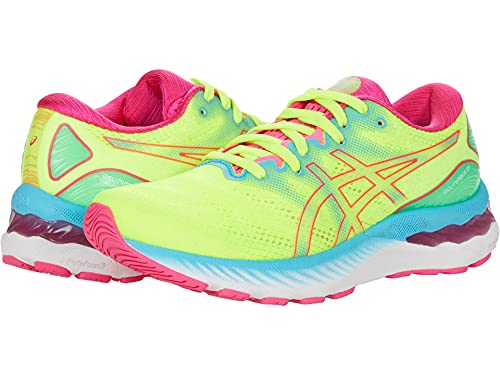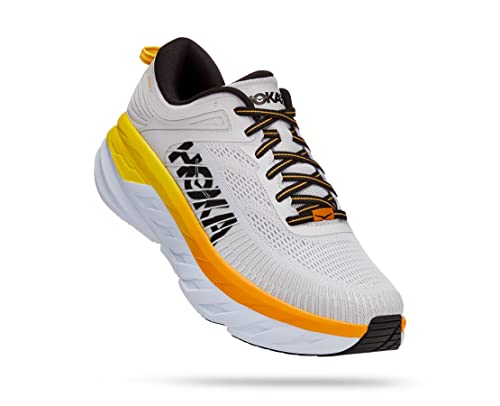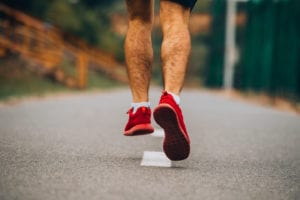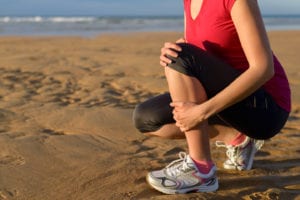- Alan Martin
If you are facing heel pain that interferes with your daily activities, it could be Achilles Tendonitis. This ailment can be the cause of a sudden injury or repetitive stress. The Achilles tendon is the large tendon that connects the two calf muscles in your leg to your heel.
Achilles Tendonitis is different from plantar fasciitis. Your healthcare provider can determine the exact cause of your pain, but each will have different areas where your pain resonates. Typically, with plantar fascia, you will experience heel pain at the bottom of your foot or the arch of your foot.
Alternatively, individuals who experience Achilles Tendonitis may have a variety of symptoms. These include:
- An ache or pain in the back of the leg above the heel
- Pain behind the heel
- Swelling around the ankle
- Tenderness or stiffness in the calf muscle
- Limited flexibility
- Cracking or creaking sound when moving the ankle
You must seek treatment for Achilles Tendonitis before your symptoms worsen. Rehabilitation exercises and the correct footwear will help to relieve any discomfort you may have. With proper care and using the correct running shoes, you can be on the road to recovery and say goodbye to heel painI.
Best Running Shoes for Achilles Tendonitis
1. Brooks Adrenaline GTS 21

Brooks offers a terrific running shoe for both men and women who suffer from Achilles Tendonitis with its Adrenaline GTS 21. It includes a medium to high arch support and its patented Guide Rails to keep your foot securely in place while you move, making it ideal for individuals with foot and heel problems.
Pros
- Extended DNA Loft cushioning
- Medium to high arch support
- Patented Guide Rails for ankle and heel support
Cons
- The shoe is a bit bulky
- Limited versatility
Takeaway
The Brooks Adrenaline Engineered Air Mesh aids in breathability while giving you a stable fit during any activity. With its added DNA Loft cushioning extends beyond the midsole to give a smooth transition while walking or running. Brooks includes its segmented Crash Pad, a fully integrated system of shock absorbers, to provide the ultimate cushioning support and landing efficiency.
2. Nike Air Zoom Pegasus 36

Pros
- Uses a slimmer heel collar that tapers away from the Achilles tendon
- Specially-designed rubber pod traction areas for effectiveness
- Flywire lacing system keeps your foot secure and comfortable
Cons
- Ten mm heel drop
- Standard fit may be too snug for individuals with wider feet
Takeaway
3. Asics Gel Nimbus 23

The Asics Gel Nimbus 23 is going to provide wearers with a firm ride and a great energy return with each step. This shoe offers a spacious fit in the midfoot and forefoot. The 23’s also have great stability from the internal heel cup, locking in the foot for maximum security.
Pros
- Ideal for underpronation or neutral movements
- Uses gender-specific forefoot outsole flex grooves for improved transitioning
- Maximum cushioning support throughout
Cons
- Neutral arch support
- Not for overpronation movements
Takeaway
4. Hoka One One Bondi 7

As one of the best road shoes in the Hoka One product line, the Bondi 7 gives a comfortable and balanced ride no matter what distance. The ultra-soft memory foam is ideal for individuals suffering from Achilles Tendonitis. The heel collar conforms to your ankle shape and cradles your Achilles comfortably without putting stress on your Achilles tendon.
Pros
- Great arch support
- Rocker midsole helps make transitions more effective
- Includes double last row lacing eyelets for heel lock lacing to prevent slippage
Cons
- Not as cushiony as Hoka's previous models
- Provides neutral stability
Takeaway
Hoka includes a full-length EVA midsole that is compression-molded for optimal support. Together with the beveled heel design and the internal locked-in Midsole, your foot remains stable even during transitioning. The TPU overlay provides an increase of support to your midfoot structure, with the Meta-Rocker for a smooth step.
5. Mizuno Wave Rider 24

Mizuno uses a dual compound midsole for the ultimate smooth performance. This special ENERZY foam midsole is versatile and aids in better performance for you. Its Wave cushioning technology boasts comfort while still giving you a secure fit during any activity. Mizuno’s redesign of the heel with the Wave Rider 24 gives ample stability and support during use.
Pros
- ENERZY foam midsole provides firm cushioning to enhance performance
- U4ic Midsole gives exceptional durability and optimal shock absorption
- Tongue wraps around the foot, so it does not slip out of place
Cons
- The midsole may be too constrictive for flat or wide feet
- Average 12mm midsole drop
Takeaway
The Mizuno Wave Rider 24 gives optimum shock absorption with its flexible and responsive outsole. These lightweight shoes are durable and ideal for anyone looking to minimize Achilles Tendonitis. Its engineered mesh materials are both breathable for your comfort and durable enough to last.
6. Asics Gel Kayano 27

For individuals who engage in competitive sports or just need a shoe to help relieve Achilles Tendonitis symptoms, the Asics Gel Kayano 27 is a terrific choice for runners. Both men and women can benefit from the maximum cushioning and medium support. Asics Dynamic DuoMax support system gives an exceptionally durable yet lightweight running shoe.
Pros
- A stable shoe for low arches or flat feet
- External heel crutch gives targeted support
- Removable sockliner for cushioning performance
Cons
- Not the best choice for underpronation gait
- Laces could be too short for some
Takeaway
This Asics running shoe is ideal for anyone with a neutral or overpronation gait. It includes the rear and forefoot GEL Cushioning system to minimize any shock during foot strike and transition. Using FLYTEFOAM Midsole Technology, the fibers have exceptional responsiveness and resist packing from use over time.
7. Brooks Ghost 13

The Brooks Ghost 13 is a mid-range neutral runner with medium to high arch support. It consists of specially engineered air mesh upper giving you a breathable shoe that fits snug around your foot. Even those with wider feet can be comfortable and fit without any rubbing or pinching.
Pros
- Extra shock-absorption with the additional heel foam padding
- Exceptional stability
- Plush BioMogo sockliner for a comfortable fit
Cons
- The outsole is prone to wearing out quickly, decreasing its durability significantly
- Standard fit may be too wide and roomy for those with narrow feet
Takeaway
Brooks includes the DNA Loft foam for supreme cushioning and comfort by extending it along the entire lateral side of the midsole. The Ghost 13 has a 12mm drop, helping to make your strides easier from heel to toe. It is one of the more flexible trainers due to its three wide flex grooves that span throughout the entire forefoot.
8. Hoka One One Clifton 7

This plush Hoka running shoe is consistent with the Hoka product line combining softness and durability. The Clifton 7 is very lightweight and yet still has a lot of toe room, even with a snug fit. The extra cushioning this running shoe provides makes it ideal for easy runs or long walks for continuous comfort.
Pros
- Delivers consistent shock absorption
- Exceptional rear foot stability
- Addition of a rear Achilles collar to eliminate pressure on the tendon
Cons
- Not ideal for fast-paced runs
- Has low flexibility for a running shoe
Takeaway
They have made a few additions to the Clifton 7, which make it stand out. The new rear pull tab/Achilles collar not only aids in putting on and taking off your shoes but also gives the rear area increased stability and support. The extra softness and rear stability are a great combination for individuals with Achilles Tendonitis.
9. Mizuno Wave Inspire 17

The Mizuno Wave Inspire 17 has made steps towards a more moderate cushioning with its ENERZY foam. Combining this with the U4ic midsole and fan waveplate, this running shoe gives a good amount of spring-back. The stacking in the Inspire 17 provides the ultimate shock reduction while being responsive.
Pros
- ENERZY heel wedge provides exceptional shock absorption
- Includes a deep rear crash pad groove and alternating tread patterns for more grip in various conditions
- The 12mm drop is noticeable but works well with the waveplate to give a firm yet responsive ride
Cons
- Heavier shoe than some may like
- The heel plate is quite stiff and inflexible compared to the forefoot
Takeaway
The double-layer mesh construction gives a snug fit to ensure your foot stays put while in use. This added layer keeps your feet warm but still allows ample airflow. The Mizuno Wave Inspire 17 is for a neutral gait, giving you a stable, comfortable running shoe overall. The geometric pattern of the rear crash pad and fan waveplate are aesthetically appealing and efficient.
10. Asics GT 2000 9

Asics gives a stable trainer that works well for individuals with a neutral or overpronation gait. Equipped with FLYTEFOAM Technology, the cushioning does not pack down with excessive use, giving you a consistent spring-back feel every time. Its Guidance Trusstic System and Line Midsole Technology use the vertical flex groove to help improve gait efficiency.
Pros
- Exceptionally durable with two outsole materials for support
- Uses better step-in feel in the footbed
- Has a precise foot lockdown to keep it in place during use
Cons
- The thick tongue can be too long and bulky for some individual’s preferences
- The midsole can be stiff and inflexible
Takeaway
The removable sockliner gives additional comfort and support while keeping your foot secure. Asics Dynamic DuoMax Support System makes this running shoe lightweight but effectively supports the platform. The GT 2000 9 includes Rearfoot GEL Technology, giving your heel added comfort and shock absorption. This GEL Technology is also found in the forefoot for added benefits.
What to Look for in Running Shoes for Achilles Tendonitis
If you suffer from symptoms of Achilles Tendonitis, having the proper running shoes is essential for minimizing your pain and helping it from becoming worse. There are several elements to the best shoe for anyone who has Achilles Tendonitis.
These factors include:
- Arch Support: Proper arch support for individuals with flat feet or low arches
- Heel Support: Ample support to keep the heel in place, so there is no rolling
- Stability: Have the support and stability to keep the foot in place
- Flexibility: Allowing a smooth rocking transition from heel to toe
- Cushioning: Plenty of cushioning to absorb impact from foot strike
- Insole/Midsole: High-quality insoles/midsoles will absorb shock
- Ankle Stack Height / Drop: A higher heel can help reduce the stress load on the Achilles tendon
- Durable Stable Heel: Should support the heel without putting pressure on the Achilles tendon
Frequently Asked Questions
Still have questions? We’ve got answers!
Is it Tendonitis or Tendinitis?
It can be either. Both are the correct spelling and refer to the inflammation of the Achilles tendon. This is also known as tendinitis of the heel.
What Causes Achilles Tendonitis in Runners?
Achilles Tendonitis can affect many runners from several elements. Overpronation or excessive supination where the foot rolls inward or outward while stepping can create a great amount of stress on the calf muscle and bring on Achilles Tendonitis.
Individuals may also experience symptoms of Achilles Tendonitis from overuse. Running for too long or too often without taking enough time to rest and recover can bring on Achilles Tendonitis. The symptoms could get increasingly worse and eventually create a large enough problem to stop running to heal correctly.
Can I keep Running with Achilles Tendonitis?
You should not run if you are experiencing pain. You must see a healthcare practitioner if you have any symptoms that could be Achilles Tendonitis. If you do have a diagnosis from your doctor, they may suggest light activity only until your tendons can fully recover. Depending on the severity of your situation, you could enjoy short, easy runs with plenty of breaks.
You do not want to increase your symptoms and should not run with pain. If you are running and begin to experience any discomfort because of Achilles Tendonitis, you should stop and take time to recover and stretch.
How Can I Prevent Achilles Tendonitis When Running?
To prevent Achilles Tendonitis from happening while you run, you must use the correct shoes. Proper footwear will keep your foot from rolling with each step and causing stress on your Achilles tendon. You can find many brands of supportive shoes that will have special heel collars for supporting the Achilles tendon while helping to relieve stress while running.
Stretching is an essential element in keeping your calf muscles flexible and healthy, especially if you run regularly. To avoid having to take time off for injury or pain, remember to perform effective calf and foot stretches to avoid having symptoms of Achilles Tendonitis.
What Happens if I Keep Running with Achilles Tendonitis?
If you have an Achilles Tendonitis diagnosis, you should take some time to let your body rest and heal before resuming regular activity. Excessive walking or running, especially with improper footwear, can increase your symptoms and cause tendon rupture or tears.
Without letting your tendons and muscles take time to heal, you risk building up scar tissue in the affected area, making symptoms permanent. Depending on the severity of your injury, it could take anywhere from weeks to months to heal properly.
Can Bad Running Shoes Cause Achilles Tendonitis?
If you are using improper running shoes, your calf muscles will work harder and could twist with each step. Achilles Tendonitis is a common result of overpronation or excessive supination. Stiff running shoes or ones that will not keep your foot in the correct position can cause Achilles Tendonitis and aggravate your symptoms.
What Are the Effects of Over and Underpronation on Achilles Tendonitis?
Pronation is how your foot rolls while you walk and run. This position can have a direct impact on the amount of stress on your Achilles tendon. Your calf muscles will have to work harder when your foot moves if you have over or underpronation.
If you have an over or under pronation gait, proper footwear is a must. By using running shoes that will keep your foot in the correct neutral position, you can help alleviate symptoms of Achilles Tendonitis and keep it from becoming worse.
What Is the Best Exercise for Achilles Tendonitis?
To reduce the symptoms of Achilles Tendonitis and keep it from returning, there are several terrific exercises you can easily do at home. The best exercises would be ones that help effectively stretch your calf muscle and increase the flexibility in your foot.
Toe Stretch: Sit on a chair and place your heel on the floor, extended out in front of you. Reach down and grab your big toe to pull it back towards your body. Hold this stretch for 15 to 30 seconds at a time.
Stair Stretch: Stand with the ball of your foot on the edge of a curb or stair. Hold onto the wall or a chair for balance. Hang your heel off the edge and slowly let your leg hang down towards the floor until you feel the stretch. Hold this position for 15 to 30 seconds.
Runners Stretch: Stand with one foot in front of the other. Lean forward and bend your front leg while keeping your back leg straight with the heel on the floor. Hold this position for 15 to 30 seconds and repeat by switching legs.
Conclusion
Dealing with Achilles Tendonitis can be difficult, especially if you do not have the proper footwear. No one wants to experience constant foot pain. Finding ways to alleviate your symptoms and keeping them from returning is critical when you have an Achilles Tendonitis diagnosis.
Having the best running shoes for Achilles Tendonitis will give you the pain relief you need while supporting your heel and calf so you can continue regular activities. Whether you stand on your feet all day for work or love to run, using proper footwear can keep you from experiencing continuous pain and making your situation worse.








